| |
Episode One: Behind the Scenes
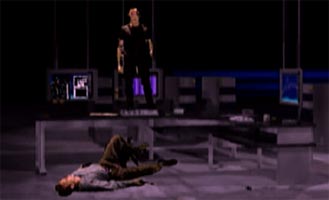
The original intent was to give Dark Commandos a "balls-to-the-walls" action send-off, with a premiere episode that would hook the audience with a rousing adventure.
To this end, writers/creators Edward Gross and Thomas Sanders designed an episode that involved helicopters, police cars and a van careening out of control as it attempts to elude capture. At the same time, it was necessary to introduce the audience to the Dark Commandos – and get a glimpse of who they are while they’re attempting to accomplish the particular mission that they’re on.
Needless to say, this was a daunting challenge, but one that the creative team felt they could pull off despite the fiscal and physical limitations of the project. More of a concern, however, was the precedence such an episode would set.
"Truthfully," says Gross, "probably two-thirds of Dark Commandos will consist of what we hope will be engrossing character interaction, with occasional large-scale doses of action adventure set-pieces. To begin the series with an elaborate chase sequence might have given the audience the wrong idea of what this show will be. It’s the problem that I think plagued the James Cameron TV series, Dark Angel. That show began with a pilot that cost somewhere around $10 million, and as a result it had a genuine feature film look and feel to it. Subsequent weekly episodes had a much lower budget and, as a result, they really don’t compare to the pilot. Tom and I realized that we would have to introduce the show in a different manner."
Sanders and Gross bandied around a number of ideas, one of which was to create an even longer Episode One that would introduce the characters of Susan Janic (a human who will eventually join the Dark Commandos), CIA director Fisher Prescott and DC operative, Dreyfuss. Thrown in the mix would also be a glimpse into Non’s past and how part of it ties in to WWII Germany. Internet bandwidth concerns, however, made this an unlikely solution as it was realized that each episode should be kept within a range of about three minutes to allow for easier downloading.
"The solution," says Gross, "was to push the chase sequence back to episode two, and open the series instead with Janic, Prescott and Dreyfuss. In the end, we changed that, as well, deciding to delay the introduction of Janic and Prescott for a few episodes (although their introductory scene was shot and may be incorporated later in a different context). We decided that it was most important to focus on Dreyfuss as he attempts to retrieve information on a target the DC is pursuing. He conveys that information to Non, and that kicks us into Episode Two."
For a brief time, the idea of the chase being featured in episode one was resurrected, in a way that would have simultaneously incorporated Dreyfuss’s quest for information. What follows is an excerpt from that script.
INT. LIMOUSINE — NIGHT
The DRIVER touches another switch, LOWERING THE LIGHTS in the passenger cabin and cueing the sunroof to start CLOSING.
The sunroof suddenly WHINES in protest.
SUITED MAN
What the hell?
He looks up and sees a MAN’S HAND gripping the sunroof from the outside and forcing it back open.
SUITED MAN(CONT’D)
Holy --
The Suited Man pushes back into his seat and goes for his gun, but before he can do so the hand reaches down from above and grabs him by the neck. He twists to see who has him.
Crouched above the sunroof is DREYFUSS who seems quite comfortable perched atop the speeding vehicle.
DREYFUSS
Where is she?
The Suited Man tries to wrestle free. Dreyfuss pulls up sharply, slamming the man’s head against the roof, stunning him.
DREYFUSS (CONT’D)
Where is she?
Dreyfuss snarls and closes his fingers around the Suited Man’s neck... drawing blood.
The Suited Man finds his gun and FIRES at Dreyfuss at point blank range. Dreyfuss winces slightly – as if he’d been pinched rather than shot – then smiles menacingly.
DREYFUSS (CONT’D)
I’m not going to ask you again.
SUITED MAN
The van. The grey van going the
other way....
|
"We weren’t completely satisfied with this particular introduction to Dreyfuss," Gross admits. "What I think we finally realized was that the first episode would work best if it were simplified to provide as strong an introduction to Dreyfuss as a character, as the more ambitious action episode would to Non and Torin."
The next pass on the sequence was drastically different, yet a step closer to the final version:
|
INT. OFFICE — NIGHT
Sole illumination of this office comes from a small desk lamp, which provides just enough light for a slimy-looking guy named BABE, who’s in the middle of a phone conversation. From what little light we do have, we can tell that this place is a shithole.
BABE
....For Christ’s sake, calm down.
Take a friggin chill pill or somethin’, will ya?...No! Stay put! They’ll
bring her right to you. Yeah, yeah, you’re doin’ great...
He slams the phone down.
BABE (CONT’D)
Where did he find these two?
A SCRATCH at the closed wooden door. Babe doesn’t seem to notice, until the scratch occurs again. Without looking up he calls out.
BABE (CONT'D)
Who is it?
Scratch, scratch. Annoyed, Babe gets up from behind his desk and moves toward the door.
BABE (CONT’D)
Y’know, I really ain’t in the
mood for this.
He swings open the door. Nothing. He looks left, then right. Shrugs and closes the door.
As he begins making his way back to his desk, the scratching starts again. He rolls his eyes, really getting pissed off. He swings the door open again.
BABE (CONT’D)
What the hell do you wa....
Again, nothing. We see him look left, right, then up and down. As he steps back into the office and closes the door, we can see concern on his face. Who’s screwing with him?
Scratch, scratch. Babe moves to his desk and removes a gun from the center drawer. Checking that it’s loaded, he turns back toward the door.
The scratching stops. Now he’s really freaked.
BABE (CONT’D)
Come on, you pussy! You wanna
play games?
He swings the door open wide and takes aim at....nothing.
There is a soft "MEOW".
Babe nearly jumps out of his skin. He looks down to find a little cat.
Babe shakes his head, manages a crooked smile, scoops up the cat.
BABE (CONT’D)
Told you you was a pussy.
(closing the door)
So where’d you come from?
A VOICE behind him.
VOICE
He’s mine.
A fist swings out and smashes Babe in the face. He slams back into the door, the cat flying out of one hand, the gun clattering away from the other.
The cat lands in the open palm of DREYFUSS, who gently puts it on the desk, strokes its head, before turning his attention back to Babe, who is bloodied and stunned.
BABE
What...do you want?
Dreyfuss carries himself like he’s the walking dead (which ain’t far from the truth). About the only thing he shows any emotion toward is that damn cat.
DREYFUSS
Where are they?
BABE
Don’t worry, she’s alive.
DREYFUSS
I don’t give a shit if she’s
alive or not. I want to know
where she is.
Babe tries to move, but Dreyfuss is right in front of him, smashing Babe’s head back against the door.
DREYFUSS (CONT'D)
Try again.
BABE
You...ain’t...Secret Service.
Dreyfuss shakes his head.
Slams Babe’s head again, the door splintering somewhat like a piece of glass with spider-web cracks. Babe is about to slip into unconsciousness.
DREYFUSS
One...more...time. Where?!
Babe lets out a hoarse whisper. We can’t hear what he says, but Dreyfuss can.
Once more, Dreyfuss slams Babe against the door. This time it shatters, and Babe flies into the hall beyond it.
SMASH CUT TO:
VAN ON THE RUN
| |
This version of the script was ultimately rewritten to make Dreyfuss’s actions more suggestive of his vampire state, and to let his adversary better convey the menacing forces the Commandos are up against.
The next draft became Episode One, now showing on DarkCommandos.com.
PRODUCTION
Production on the first ten episodes of Dark Commandos got underway on October 26, 2000 at Essex Studio in Burbank, California. Episode One, although not the first one shot nonetheless serves as a perfect example of the challenges behind bringing the series to life.
"Because it was to be the first in the series," says Sanders, "This is where we would first prove to ourselves that we could shoot dramatic material in a completely artificial environment and be able to later composite it convincingly with the virtual sets we were designing in the computer. This was essential, because it was the strategy on which we had based our entire budget and concept for the series. That is, we didn’t expect to be able to out do feature film or even broadcast television budgets, but we did want the freedom to be able to create the universe we envisioned and tell the stories we had imagined. A successful workflow integrating live action video, convincing virtual sets and robust compositing capabilities were the keys to be able to do this. We had done a number of tests in the previous nine months, but this was the first time real money was on the line. Happily, the results were very encouraging."
Confidence and belief in the project was important to cast and crew from the beginning. The truth of the matter is that the actors involved in the sequence — Bradley Upton (Dreyfuss) and Jason Cole (Dwight) — had little more than each other to play off of. They were on a stage painted green with a minimum number of props, fully aware that their environment would be added later.
"Dark Commandos was always going to heavily utilize computer generated images," notes associate producer Michael McPhillips. "But as the shoot got underway, it was realized we could do even more in the computer than we had originally thought. In Episode One, the only ‘real’ elements are the actors, Dwight’s chair and the keyboard. Even the table that Dreyfuss crouches on didn’t really exist. It was actually a piece of plywood, painted green and supported by crates also painted green."
Yet despite what would be a virtual environment, both Cole and Upton were able to bring the sequence to riveting life through their respective performances.
"For that first scene," explains Upton, "I just tried to keep it simple. There was no reason to be an over-the-top, gibbering, sort of drooling vampire. There was no reason to go overboard. Dreyfuss was very business-like, ‘I’m going to kill you, and you can go out bad or not so bad.’ Just from the lines you can assume that he might have let Dwight go. You know, ‘You may have bought yourself a new lease on life,’ and then he has the nerve to pull the gun and shoot me, so I kill him. Too bad, because I would have let him go."
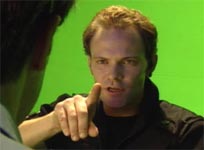 The greenscreen, he adds, did not distract from his performance at all. "I’ve worked on greenscreens before," he notes. "I’ve done a couple of CD-Roms which never actually saw the light of day because the company went bankrupt while we were shooting, but acting is acting. I act in this one theater in LA and basically there aren’t a lot of props. The scenery doesn’t change because it’s a black-box theater and you just sort of cope with everything you need in your imagination and other things that people are giving you. It wasn’t that difficult. Actually, when I was straddled between two ladders so that they could get the over-the-shoulder shot on Jason, when I was doing lines, the only thing I really saw was Jason’s face. The whole greenscreen sort of crept in and all I was looking at was sort of his head floating. It was really weird; I haven’t had that happen before unless I’m really concentrating on something. All I needed to play the scene was the other actor." The greenscreen, he adds, did not distract from his performance at all. "I’ve worked on greenscreens before," he notes. "I’ve done a couple of CD-Roms which never actually saw the light of day because the company went bankrupt while we were shooting, but acting is acting. I act in this one theater in LA and basically there aren’t a lot of props. The scenery doesn’t change because it’s a black-box theater and you just sort of cope with everything you need in your imagination and other things that people are giving you. It wasn’t that difficult. Actually, when I was straddled between two ladders so that they could get the over-the-shoulder shot on Jason, when I was doing lines, the only thing I really saw was Jason’s face. The whole greenscreen sort of crept in and all I was looking at was sort of his head floating. It was really weird; I haven’t had that happen before unless I’m really concentrating on something. All I needed to play the scene was the other actor."
"The challenge of directing such an effects-dependent project as DC," says Sanders, "Is to make sure you come out of principal photography with dramatic elements that will integrate seamlessly with equally important material that won’t even be created until weeks or months later in post-production." In Episode One, for example, Dwight is alone on camera for half the scene, while the stealthy approach of the vampire is represented only by sound and visual effects which wouldn’t be added to the scene until long after the actor had left the stage. "It requires a certain degree of faith on behalf of cast and crew, that it’s all going to come together in post," emphasizes Sanders. "Fortunately, we were blessed by a talented team of pros, both behind and in front of the camera, who really threw themselves into meeting the unique challenges of this project."
McPhillips praises both actors, particularly, while noting that Upton played no small part in adding some flesh to Dreyfuss’ undead bones. "The old phrase ‘clothes make the man’ is definitely true in the case of our Commandos," he says. "The clothes they wore had to express who they are and some of their history. The most challenging was Dreyfuss. Dreyfuss is something of an enigma and he’s definitely the ‘meanest’ of the team — there’s not much that makes him happy. We know from his history that for almost a century he has been a mercenary, but there had to be more to his costume than just camo pants and fatigues. This is where Bradley Upton was a great help. From the start he had a terrific insight to his character. Much of the final look of Dreyfuss’ clothes are a direct result of Bradley’s help. He would scour Army/Navy stores and call me up and tell me about a great vest or some other piece he found. Dreyfuss is also the only Commando who goes out on every mission armed. Since vampires have preternaturally enhanced strength, speed and senses, they’re not going to need to be slinging a lot of firepower (at least not for every mission). The sheaths on Dreyfuss’ arms, though, contain Ninja-derived throwing stars. Combined with his enhanced abilities, they make quick and silent work of any target from a discreet and concealed distance."
As to Jason Cole, he explains that the actor had read for a considerably smaller part, but was so impressive in his audition that it was believed he would be the perfect person to open the series with.
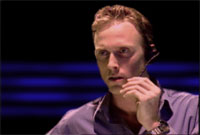 "I think the reason he floored us is readily apparent in the episode," says McPhillips, who next turns his attention to Cole/Dwight’s final moment: falling backwards, dead, Dreyfuss having flung a bullet into his forehead. "We took Jason off to a quiet corner of the stage and while the crew was setting up the next shot, we set up some mats, took the wheels off the chair and Jason spent the next 10 to 15 minutes tipping himself over. It’s not as easy as it looks. Your first instinct is to catch yourself, but Dwight couldn’t do that, of course, since he was dead. It wasn’t the most difficult of stunts, but I have to give Jason credit." "I think the reason he floored us is readily apparent in the episode," says McPhillips, who next turns his attention to Cole/Dwight’s final moment: falling backwards, dead, Dreyfuss having flung a bullet into his forehead. "We took Jason off to a quiet corner of the stage and while the crew was setting up the next shot, we set up some mats, took the wheels off the chair and Jason spent the next 10 to 15 minutes tipping himself over. It’s not as easy as it looks. Your first instinct is to catch yourself, but Dwight couldn’t do that, of course, since he was dead. It wasn’t the most difficult of stunts, but I have to give Jason credit."
As Episode One moved into post-production, it was obvious that the challenges had just begun.
POST-PRODUCTION
Beyond co-creating, co-writing, directing and editing the series, Tom Sanders was also in charge of visual effects.
"The job fell to me because of budget constraints and my long-time interest in special effects," he says. "The first shot I tackled in the Dwight scene was the moment when he grabs the gun and gets off a shot at Dreyfuss. After working for several days and nights on the shot, I gleefully phoned Ed to tell him I was ready to show the first completed shot of the series. ‘How long is it?’ he asked. ‘Eight frames,’ I answered, proudly. "Eight FRAMES?" There was a long silence. Perhaps this moment more than any other, drove home the reality of what we had gotten ourselves in to.
"That those eight frames took several days to accomplish may sound daunting, but I think the fact that they were accomplished by a single individual, instead of the teams of specialists a bigger show would have relied on, points to a revolution in digital filmmaking. These capabilities are coming into the reach of anyone willing to undertake the steep learning curve." Over the next three weeks, 38 additional shots were completed, resulting in a 2 minute, 40 second scene, every frame of which contains CGI elements.
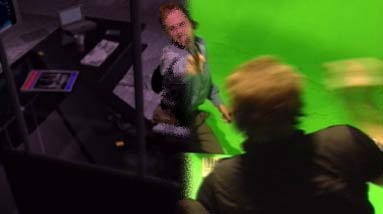
The scene in question began with footage shot on an entirely green set. In post-production, eight separate elements were added to the shot in discreet layers. The green studio floor was replaced by the concrete of a dark, foreboding warehouse. Dwight casts an artificial shadow on the virtual floor, and a fake reflection on a non-existent desk. His plastic prop gun fires digital gunpowder.
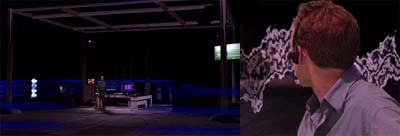
Surrounding the action is a futuristic laser barrier, the penetration of which became a key shot in the scene, even though it was not even conceived until long after principal photography.
As Dark Commandos premieres, the audience will be the judge as to whether or not the creative team has been able to achieve their goals. But Upton, for one, is confident, comparing the first two episodes of the series to the pre-credit sequence of a James Bond movie -- if not in scope then certainly in intent.
"At the beginning of a Bond film, you’ve got a scene filled with action and adventure and explosions that really doesn’t have a whole lot to do with the movie," he opines. "It just illustrates that Bond is really cool and that he’s the best. This is sort of a James Bond beginning."
And for Dark Commandos, the adventure has only begun.
TRIVIA
- Sharper-eyed viewers may notice the bullet that Dreyfuss catches and kills Dwight with. That was real, but the pistol was a (non-operational) 9mm Baretta, while the bullet a .45 caliber. The larger caliber bullet was used so that it would be easier to see.
- Dark Commandos’ director of photography, Bodo Holst, had to compose each shot with light only since there were virtually no physical set pieces. The pulsing blue light of the laser barrier, the overhead illumination, the light from the computer monitors all had to be anticipated and then rigged by his crew. More examples of his work will be seen in upcoming episodes. As you watch, try to mentally subtract all the virtual scene elements and you’ll discover just how complex a task it is to bring the Dark Commandos universe to life.
|